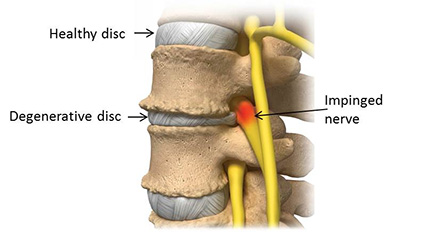|
7/11/2016 0 Comments Degenerative Disc Disease More than 65 million Americans a year suffer from lower back pain and by the age of 50 over 85% of the population will show some evidence of disc degeneration. However, the majority of these people, showing disc degeneration, will be asymptomatic. Your spine contains 33 vertebrae, or bones, and separating the vertebrae are 23 soft, compressible, discs that are meant to aid in shock absorption, increase your range of motion, and prevent bone from grinding on bone. These discs are tough on the outside and gel-like on the inside allowing for water loss throughout the day. In one day we can lose almost 3/4 of an inch in height due to said water loss in these discs but, as we sleep most of the water is restored. Notice that only most of the water comes back, not all of it, because over time the everyday wear and tear that we put on our bodies will lead to an overall reduction of fluid (in the discs). As a result many middle-aged and older adults experience back pain of varying degrees associated with a condition known as Degenerative Disc Disease, or DDD. DDD, although not truly a “disease”, is a condition in which the discs of the spine begin to degenerate, or deteriorate, and become increasingly thinner, stiffer and more brittle. Disc degeneration is quite common and is a normal part of the aging process of the spine. Pain from DDD ranges from excruciatingly painful to no pain at all depending upon the individual and the severity of degeneration. Degenerative Disc Disease is diagnosed after x-rays and other forms of imaging have been reviewed by your doctor. Common symptoms of Degenerative Disc Disease, if any are experienced at all, include pain that is related to activity, bending, twisting, or lifting, and sometimes the specific way the body is positioned. For instance, if the degeneration is in the lower back then sitting will be more painful as it places a lot of pressure on that region. Further symptoms can include chronic back pain, severe episodes of neck and back pain that last days or even months, and seemingly inexplicable pain in various parts of the body (due to nerve impingement). Disc degeneration can lead to a number of other issues including numbness, tingling, stiffness, bone spurs, nerve impingement, and sciatica. So what can you do? Unfortunately, disc degeneration cannot be reversed but there are ways to manage the pain. Conservative care options include exercise, physical therapy, medications, and, of course, chiropractic care. The chiropractor’s goal for treatment of DDD is to return as much of the lost flexibility to the spine as possible by reducing inflammation, relieving pressure on surrounding nerves, and improving spinal motion. Because chiropractors treat the whole person, treatment plans can include thrusting and non-thrusting adjustments, depending on the severity of degeneration, trigger-point therapy to reduce muscle tension, soft tissue therapy using Graston technique, electrical stimulation, ultrasound therapy, nutritional counseling, stress management strategies, and therapeutic exercises amongst other things. All aforementioned aspects of treatment will reduce the symptoms associated with DDD. Furthermore, regular visits to your chiropractor can reduce the progression of Degenerative Disc Disease and even, in rare instances, aide in the regeneration of such discs. Sources: SpineUniverse:http://www.spineuniverse.com/conditions/degenerative-disc/chiropractic-care-degenerative-disc- The Joint Chiropractic: http://www.thejoint.com/california/lake-forest/lake-forest-31004/can-chiropractic-care-help-disc-degeneration?umrids=931 Spine-health:http://www.spine-health.com/conditions/degenerative-disc-disease/common-symptoms-degenerative-disc-disease http://www.setonbrainandspine.com/treatment/spine/degenerative-disc-disease Katie LaBarge St. Lawrence University '16 Chiropractic Assistant
0 Comments
Leave a Reply. |
AuthorMalorie Gardner, D.C. Archives
October 2016
Categories |
Website by North Shore Solutions
 RSS Feed
RSS Feed